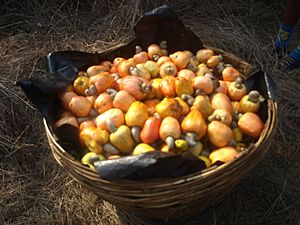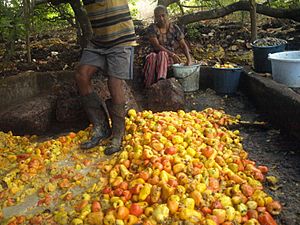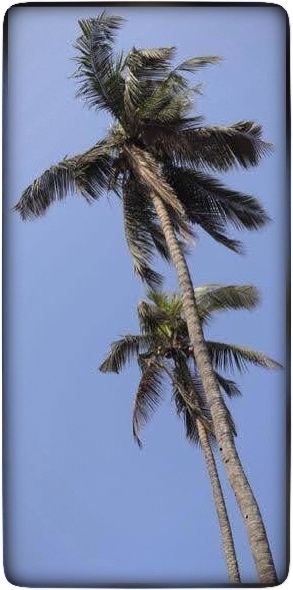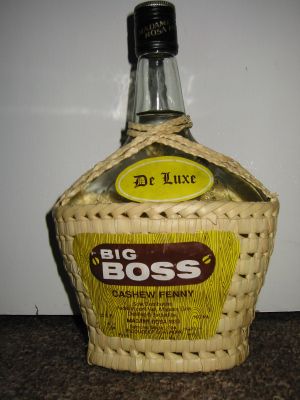Feni (liquor) facts for kids

Feni is a special traditional drink from the state of Goa, India. The two main types of feni are Cashew feni and Coconut feni. These names come from the main ingredients used to make them. There are also other kinds and new mixes available. Feni is made in small batches. This careful process helps it keep the delicate smells and tastes from the original fruit juice.
The word feni comes from a Sanskrit word meaning "froth" or "foam". This might be because of the bubbles that appear when the drink is shaken or poured. People generally believe that coconut feni was made first. Cashew feni then followed a similar process. Coconut trees are common along the western coast of India. However, the cashew tree was brought to India by the Portuguese in Goa and Bombay. They brought it from what is now colonial Brazil in south America. It is not clear when or who first made a fermented drink from cashew fruit to create feni.
Feni made in southern Goa usually has a higher alcohol content (around 43–45% alcohol by volume). Feni from northern Goa is slightly less strong. You can buy commercially bottled feni with about 42.8% alcohol.
Contents
How Feni is Made
Making Cashew Feni
To make cashew feni, people traditionally only use cashew apples that have fallen from the tree when ripe. These cashew apples are first de-seeded. Then, they are put into a special stomping area called a collmi. This collmi is usually a basin-shaped rock. Workers stomp on the cashew apples to get the juice out. Today, people often use a press called a pingre instead of stomping. The leftover pulp is then pressed again. This second juice is called Neero/Niro. It is refreshing to drink but not usually used for making feni.
The first juice, from stomping the cashew apples, is put into a large clay pot called a koddem. This pot is buried halfway in the ground. The juice then ferments for several days. Today, plastic drums are often used instead of clay pots. The juice ferments for about three days. No extra yeast or nutrients are added to speed up this natural process.
Cashew feni is made using a traditional distillation method. The machine used for this is called a bhatti. The boiling pot, once made of clay, is now often made of copper. It is still called a bhann. The distilled liquid is collected in a clay pot called a launni. In the past, cold water was poured on the launni to cool it down. Now, a coil is placed in cold water to condense the liquid.
Cashew feni is distilled three times. The first liquid from the fermented neero is called Urrak. It has about 15% alcohol. Urrak is then mixed with more neero and distilled again. This makes a drink called cazulo or cajulo, which has about 40–42% alcohol. Cazulo is distilled one more time with Urrak to make feni, which is stronger (about 45% alcohol). Most cashew feni you find today is double-distilled.
Making Coconut Feni
Coconut feni, also known as Maddel, is made from fermented sap of the coconut palm. This sap is called toddy. A person called a Reindér collects the toddy from the coconut palm. Collecting sap from palm tree flowers has been done in India and Southeast Asia for many centuries. The sap is collected in a clay pot called a zamonnô or damonnem. This pot is placed over the flower stalk (ipoi) of the coconut tree.
To get the toddy, the flower stalk is tied tightly with a rope. It is then gently tapped with a knife handle every other day. This makes it round and flexible, showing the sap is ready. The tip of the stalk is then cut off. This allows the sap to drip into the damonnem pot.
Toddy is collected from the damonnem in the morning and evening. It is then carried down the tree in a gourd-shaped container. Finally, it is poured into a clay pot called a kollsô. The flower stalk is sharpened at noon by slicing a small piece off the top. This helps the sap keep flowing. For three days, the toddy ferments in clay or porcelain pots.
Coconut feni is mostly made and enjoyed in South Goa. It is also distilled using traditional pots. The place where coconut feni is made is called a sôreachi bhatti. The boiling pot, once clay, is now often copper. It is still called a bhann. The top of the bhann is sealed with a wooden stopper. The steam from the bhann goes through a tube and is collected in a clay pot called a launni. This launni sits in a larger clay vessel filled with water. A copper coil is placed in cold water to cool the steam and turn it into liquid.
Bottled coconut feni usually has about 42.8% alcohol. Coconut feni is distilled twice. The first liquid is called a mollop, with about 15% alcohol. Four pots of mollop are then mixed with one pot of toddy. This mixture is distilled again to make the stronger coconut feni.
Selling Feni
The market for selling feni is not very organized. Local people often buy feni directly from the many traditional makers. These makers run small distilleries or stalls in the villages of Goa. A lot of feni is sold directly by these makers to local taverns. These business relationships have often lasted for generations.
Cashew feni is only made during a certain time of year, from late February to mid-May. Its production depends on how well the cashew trees fruit that season. The price of cashew feni also changes based on the fruiting season.
Coconut feni is made all year round because coconut trees produce toddy throughout the year. During the monsoon season, coconut palms produce more toddy than in drier months. Collecting toddy is hard work. Because of this, fewer people want to do it. This has led to a big drop in how much coconut feni is made.
There are also many brands of feni sold in bottles for tourists. In recent years, local people have slowly started buying these standardized bottled feni products.
How Feni is Used
Feni can be enjoyed on its own or with ice. It can also be mixed with other drinks like juices or sodas. People often serve it with a slice of lime, and sometimes with sugar or sugar syrup.
Popular mixers include cola, tonic water, and lemonade. Lemonade is probably the most popular. Feni is also often mixed with Limca, Maaza, Sprite, or 7up.
Feni is also used in cooking. For example, it can be part of a marinade for pork. It is mixed with garlic, ginger, Indian spices, and vinegar. This mixture is the base for the famous Vindaloo curry.
Special Recognition
In 2009, cashew feni received a special recognition called Geographical Indication. This means it is officially recognized as a unique alcoholic drink from Goa. It is described as a clear liquid that turns golden brown when aged in wooden barrels. This recognition was achieved thanks to the efforts of the Goa Cashew Feni Distillers & Bottlers Association and the Government of Goa. However, coconut feni has not yet received this special recognition.
A Heritage Drink
In 2016, the government of Goa started a plan for feni to be known as a heritage drink outside of Goa. Goa's Chief Minister, Laxmikant Parsekar, said that feni is "part of our culture." There are plans for "nature tourism." Tourists could see how cashews are harvested and how feni is made. Several feni makers have asked the government to create rules for making feni and make sure they are followed. Issues like fake feni and poor quality were discussed.
See also
 In Spanish: Fenny para niños
In Spanish: Fenny para niños





